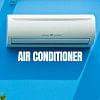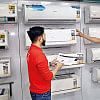Evolution of Air Conditioning

Initially ACs were large and expensive and primarily used for commercial purposes. The technology slowly became affordable through increased use in public places such as department stores.
As the mercury's rise will presumably show no sign of letting up at least until mid-June in Bangladesh, many will be resorting to air conditioning units to beat the sweltering heat.
There are alternatives to cooling off which were practiced in the good old days, such as taking a dip in a water body, relishing an ice lolly or simply sitting in the cool shade under a gigantic banyan tree's thick canopy.
Still, it is hard to beat this 21st century's climate controlled rooms. The rise of HVAC (heating, ventilation and air conditioning) systems have fundamentally changed the way people go about their everyday lives.
It all started off around 1850 with the designing of a simple machine that creates ice using a compressor powered by horse, water, wind or steam. It would take another 50 year or so for the first air conditioner (AC) to be invented.
Initially they were large and expensive and primarily used for commercial purposes. The technology slowly became affordable through increased use in public places such as department stores.
The first residential unit was developed around 1950 and its use slowly became widespread through improvements, such as the development of central air conditioning systems which are able to cool whole houses.
Energy price hikes in the 1970s shifted the focus on achieving energy efficiency while ensuring effective cooling. Hence variable speed compressors and improved insulation methods were developed.
From the 1990s, ozone-depleting chlorofluorocarbons started to be phased out and be replaced by new refrigerants to make air conditioners more environment friendly and achieve better performance and efficiency.
Over the past decade or so, manufacturers came up with non-vapour compression technologies, smart thermostats and home automation systems allowing remote control and optimized energy use, zoned cooling through ductless mini-split systems and apparatus for air purification and ventilation.
And products making use of such advanced technologies are being offered right here in Bangladesh by household appliance makers. Take the case of Walton Group.
The local electronics giant offers variable refrigerant flow, which is an air-conditioning configuration with one outdoor condensing unit and multiple indoor units. Its air conditioners can be run on offline voice commands in Bangla and English alongside smartphones, calculate electricity bills and release ions to reduce airborne particles. They also have an automatic cleaning feature.
"Walton has already brought ACs with 5.5 star energy rating, which is one of the most energy efficient ACs in the world. We are using eco-friendly R-32 and R-410 refrigerant on our ACs for which they are most environment friendly," said Engineer Ariful Islam, head of Walton AC's Research & Innovation.
"We have a strong Research & Innovation team with highly efficient engineers and giving highest priority to make ACs most energy efficient and environment friendly. Customers will get more and more technologies, energy efficient and environment friendly ACs in future," he said.
An assortment of air filters is provided in Elite Hitech Industries Ltd's "Elite" and "Midea" air conditioners.
Depending on the type, they may include an antibacterial filter, "anti fungus" HEPA (high efficiency particulate air) filter, carbon fibre filter, "Vitamin C" filter, HAF (high air flow) electrostatically charged filter, nano filter and bio filter.
One Midea AC comes with a DC inverter compressor, which are much more economical and safer than ACs with a constant output of compressor, said Moztaba Nadim, brand manager at Elite Hitech Industries Ltd.
The DC inverter units convert incoming AC current to DC and produces current of desired frequency to control the speed of the compressor motor so as to continuously regulate the temperature.
The company conducts little marketing and focuses on performance with the latest psychrometric laboratory for R&D, added Nadim.
Singer Bangladesh Limited also offers a "4 in 1 filter" in its air conditioners, saying it ensures micro-particle filtration for a cleaner air flow. They are also said to be able to detect the zone where the user is to direct a four-way air flow (up, down, right and left).
Singer Green Inverter AC has eco-friendly R32 gas which saves up to 60 per cent electricity compared to normal AC, said Chandana Samarasinghe, marketing director at Singer Bangladesh Ltd.
If there is no gas in the compressor, an E9 signal will appear on the AC display and the AC will not run until the gas is refilled, he said. Moreover, its state-of-the-art technology keeps the AC running amidst voltage fluctuations and even at only 150 volts, he added.
The temperature can be conveniently maintained through an "I-Feel" mode by Electro Mart Ltd's GREE air conditioners.
A temperature sense technology adopted by the remote controller can intelligently detect the temperature around the user and automatically send the information to the unit every 10 minutes to conduct adjustments accordingly.
The ACs also have a "Self Diagnosis" option. Once abnormal operation or part failure occurs, the unit shuts off automatically to protect the system while displaying protection or error code for fast service.
Thanks to technological upgrades and their low power consumption, the ACs with inverters account for 65 per cent of Electro Mart's AC sales whereas it was the opposite just three years ago, said Nurul Afsar, deputy managing director of Electro Mart Limited.
He believes in the future non-inverter ACs would be forced out of the market as demand for those was going down continuously.
Apart from Samsung, Panasonic, Hisense and Toshin ACs, RANGS eMART recently launched LG ACs with "Dual Inverter Technology", saying they are 70 per cent more energy efficient and offer 40 per cent faster cooling than conventional ACs.
RANGS eMART is focused on technologically superior ACs, which put power efficiency and product innovation above everything else, said Raihan Ahmed, category head, RANGS eMART.
A new range of energy-efficient and IoT-based AC models from well-known manufacturers will be released soon, he added.
Air conditioning technology is likely to continue to evolve to be more effective and affordable, with a focus on more sustainable refrigerants alongside energy efficiency and integration of renewable energy sources such as solar power.

 For all latest news, follow The Daily Star's Google News channel.
For all latest news, follow The Daily Star's Google News channel. 








Comments